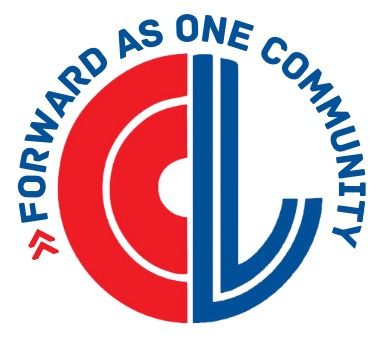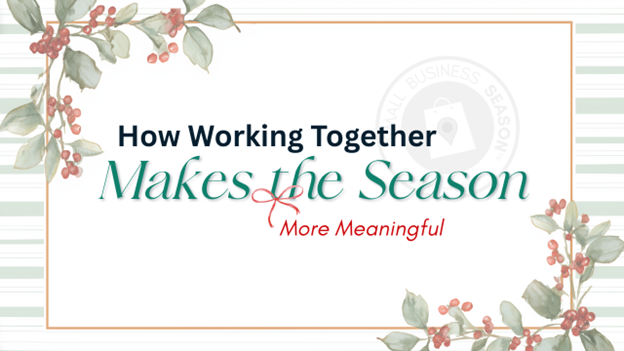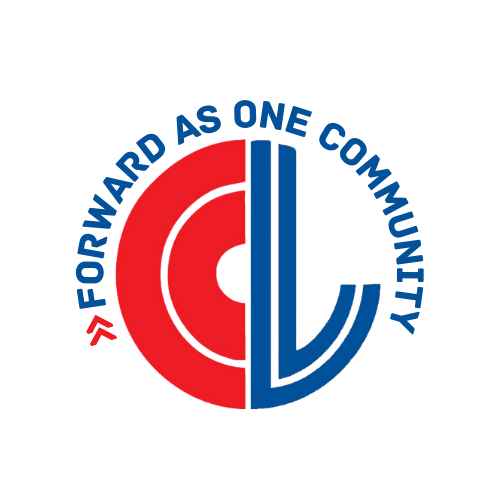News
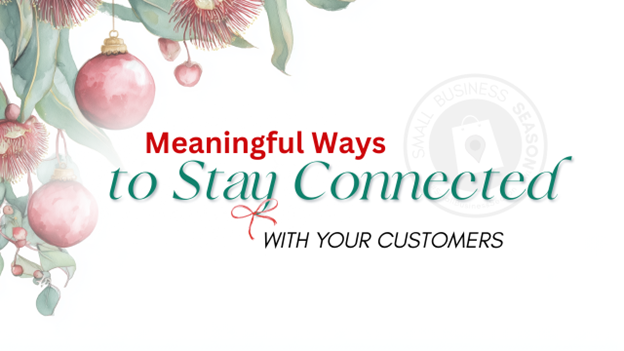
We made it through Small Business Saturday, and we hope it was a great one for you. But guess what? The holiday season shifts into high gear from now on. Foot traffic gets wild, inboxes overflow, and your customers are juggling a million decisions at once. They’re feeling the pinch of not having enough time. In the middle of all that zaniness, your biggest advantage as a small business is the experience you create and the connection you keep. People want to support local. They just need reminders that you’re here, you’re human, and you’re worth choosing. Here are simple, sustainable ways to stay engaged all month long without adding stress to your plate. Show the “Real Life” Moments Behind the Scenes People love feeling like they’re part of the process. A quick photo of your team wrapping orders, prepping inventory, or laughing their way through a busy day makes your business feel warm and relatable. No polish required. A little authenticity builds a lot of loyalty. Use Countdowns That Build Excitement You don’t have to be a big-box brand to create anticipation. Try a countdown to shipping deadlines, holiday bundles, in-store specials, or even a “12 days of local shopping” series. It keeps you top-of-mind and gives your audience a reason to come back tomorrow. Spotlight the Customers Who Keep You Going Feature a shopper of the week, share a heartwarming review, or highlight a longtime supporter. Even better, ask customers to tag you so you can repost. These little spotlights do two things: they show gratitude and they hint to others that they could be featured next. You don’t have to be in retail to participate in this for the holidays. One veterinarian decided to post a picture of the “Pet of the Month” in the lobby and now all their clients want to know how they can get their pet featured. Say a Genuine Thank You—And Say it Often In the holiday rush, people crave sincerity. A quick post thanking your community for shopping local makes a bigger impact than you think. Gratitude reminds people they’re participating in something meaningful, not just making a purchase. When people buy from you, don’t just thank them. Go a step further and tell them why it means so much to you. A couple of extra words can make them feel like hometown heroes. Additionally, if you had someone who just bought a lot from you (or someone who buys on a regular basis), send a handwritten card offering a discount. It doesn’t even have to be large ( or it could be based on another purchase, like a “buy one, get X% off the second one”). It’s much easier to get a past customer to buy again than a new customer. Repurpose Your Content Across Platforms You don’t have to reinvent anything. A behind-the-scenes video becomes a Reel, which becomes three photos for Facebook and a carousel post, which becomes a still image for your Google Business profile. A customer spotlight or Google review can double as a testimonial on your website. Make your content work harder for you. Share Small, Helpful Reminders Post your hours, gift ideas, top sellers, or last-minute stocking stuffers. Highlight easy wins like “order online, pick up in store,” or “gift cards available.” These practical posts reduce friction and help customers make quick decisions. Ever wonder why candy is right next to every cash register? It’s an easy impulse buy. When you make suggestions or bundle products for ease and value, it helps your customers take quick action. After all, as much as we all love the holidays, they’re a lot of work and any help we can get from others to lessen decision fatigue makes our lives easier. Lean into Community Connection When you’re local, you have something bigger than any national chain: roots. Celebrate other small businesses, share local events, or partner with a neighbor for a cross-promo. Customers love seeing small businesses support one another. Spur on Impulse Buys There are some things people always need more of during the holidays. If you operate that sort of business, consider a “secret” bonus offer that is revealed at the register and they have only minutes to decide. This worked well at a winery. When customers purchased one or more bottles, they had the opportunity to buy additional bottles in that transaction for 20% off. It was a great way to incentivize people to make a quick decision on something they knew they would use ( or could give as gifts or hostess presents). Close With Consistency, Not Perfection You don’t need a massive campaign to stay connected this month. You just need regular touchpoints that feel personal and true to who you are. Show up consistently, give people something to smile about, and remind your audience why shopping small matters—not just on Small Business Saturday, but every day this season and beyond. If you keep customers feeling included, appreciated, and excited, you won’t just ride out the holiday craziness. You’ll turn this month into momentum for the new year. -------------------------- Read More: Building a Fanatical Following with Email How Real Stories are Boosting Business Sales How to Win Over Customers with Emotional Marketing
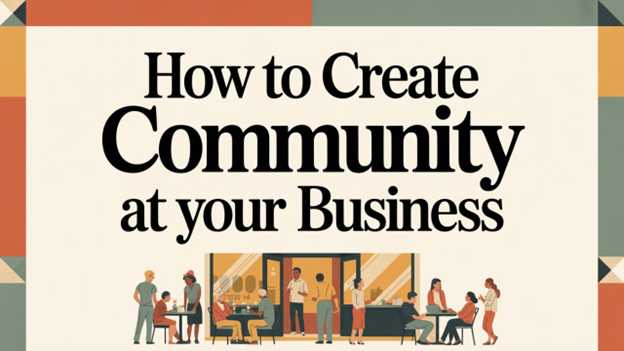
If you have repeat customers, you already have the foundation of something powerful: a community. You just need to ensure they understand that. Not a punch-card club. Not just “regulars.” A real group of people who feel connected to you, your team, and each other. Community is what keeps people choosing you even when a cheaper, closer, or flashier option pops up. It is also a lot more fun than chasing new customers all the time. Here is how to turn those repeat visits into a community that loves coming back. Shift from Transactions to Relationships Most businesses stop at “Thank you, have a great day.” Community starts when you get curious. Ask yourself: · Do I know anything about the people who come back again and again? · Would I recognize them outside the business? · Do they feel like guests, or like familiar faces? You do not have to become everyone’s best friend. But a small shift in how you see them changes everything. When you view repeat customers as “our people,” you naturally look for ways to take care of them, remember them, and connect them. That is the beginning of community. Learn Names, Then Learn Stories One of the simplest, highest-ROI moves you and your staff can make is learning names and using them. “Hey, good to see you again” is nice. “Hey, Maria, how did your event go last weekend?” is loyalty. You can make a quick note after a conversation in your POS system or a notebook behind the counter. Capture just a few details: kids’ names, pets, big projects, favorite order. Train your team to glance at those notes before serving someone. You are not being intrusive. You are being attentive. In a world where most people feel invisible, that level of care is rare. Over time, you will know who just started a business, who is new in town, who is training for a race, who is caring for a parent. That is how your space stops feeling generic and starts feeling like “their place.” Create Simple Rituals People Can Join Community loves a shared ritual. This does not have to be complicated or expensive. Think about small traditions, such as a “regulars’ hour” once a week where you test new items, a wall of fame for long-time customers or milestone purchases, or a daily question on a chalkboard that everyone can answer. Rituals give people a reason to come back and something to talk about. When someone says, “On Fridays they always…” that is community behavior. You have given them a story to tell. Start a Club That Gives People a Reason to Return One of the strongest ways to turn repeat customers into a true community is to create a recurring club that meets at your business. The club should fit your brand and your customers’ interests. For example: · A bookstore or café could host a monthly book club or writers group. · A yarn, craft, or gift shop might host a weekly knitting circle or “maker morning.” · A fitness studio could run a “goals group” that meets once a month for coffee and conversation. · A wine bar could host a “Wednesday Tasting Club” where members try a new flight together. Keep it simple: 1. Choose a consistent day and time. 2. Give the club a name so it feels special. 3. Offer a small perk for participants, such as a discount, early access to products, or a reserved table. Over time, the club becomes a steady heartbeat in your business. People come not only for what you sell, but for the friends they know they will see there. Turn Repeat Customers Into Insiders People do not just want to buy from you. They want to feel in on it. Treat your regulars as insiders, not just transactions. You might give them early access to new products or menus, “first to know” messages about special items or events, or a quick behind-the-scenes look at what you are working on next. Ask for their input: “We are thinking about adding X. What do you think?” “We have two logo options for this new product. Which one would you pick?” When customers feel like insiders, three things happen: they show up more often, they bring people with them, and they defend you when someone criticizes you online. Make Your Space a Place to Connect Community is not just between you and your customers. It is also between your customers and each other. Look for small ways to help that along. Arrange seating so people can sit, not just stand in a line staring at their phones. Host tiny, low-pressure events: coffee tastings, lunchtime learning sessions, local maker pop ups, or “meet the owner” Q&As. When it feels natural, introduce people: “You two are both new business owners on this street, you should meet.” “You both come in after the school run. Have you met?” You are not planning a conference. You are creating moments where conversation is possible. Those moments are what people remember. Share Their Stories, Not Just Your Promotions If every post or email is “Here is what we are selling,” your marketing will always feel like noise. Community-building content looks different. You highlight customer stories and shared moments. You might feature short spotlights of regulars, with a photo and a quote about why they come in. You can show customers enjoying your space (with permission, of course), or share stories of how your customers support one another, like referrals or collaborations that started at your business. This makes featured customers feel seen and signals to everyone else, “People like you belong here.” Suddenly your brand is about more than what is on the shelves or the menu. It’s about who gathers around them. Build Light Systems So It Survives Busy Season Community sounds warm and fuzzy, but it works best with a little structure behind it. To keep it going even when you get swamped, create a simple “regulars” tag in your POS or email system. Add a short team habit, such as “two genuine conversations per shift” or “ask one follow-up question of a regular each day.” Once a month, review who you are seeing a lot and who you have not seen in a while. You do not need a complicated points program. You need a repeatable way to notice, remember, and appreciate the people who show up. The Quiet Advantage of Being “Their Place” When customers feel like they are part of a community at your business, a few things shift quietly in your favor. They are more patient when something goes wrong. They choose you even when a big chain runs a sale. They tell people about you without being asked. In a world where so many experiences feel rushed and anonymous, being the business that remembers their name, knows their story, invites them into clubs and rituals, and connects them to others is not just nice. It is a serious competitive advantage. You are not just building foot traffic and revenue. You are building a small, loyal neighborhood around your business, one repeat customer at a time, and that feels really good for everyone involved. Read More: 5 Customer-Focused Strategies to Build Loyalty and Drive Growth Hospitality is the Hidden Edge: Why Emotional Connection Drives Customer Loyalty Winning Back Lost Customers: Smart Strategies to Reignite Trust and Revenue -------- Christina Metcalf is a writer and women’s speaker who believes in the power of story. She works with small businesses, chambers of commerce, and business professionals who want to make an impression and grow a loyal customer/member base. She is the author of The Glinda Principle , rediscovering the magic within. _______________________________________ Medium: @christinametcalf Facebook: @tellyourstorygetemtalking Instagram: @christinametcalfauthor LinkedIn: @christinagsmith

Even with concerns about the economy being on every newscaster’s lead story, the holidays haven’t been cancelled. Your customers are still planning to celebrate. The question is not “Will they spend?” It is “Where, how, and with whom?” Here is the good news: national forecasts say 2025 holiday retail sales are expected to top 1 trillion dollars for the first time, with overall growth around 3.7% to 4.2% over last year. Online spending alone is projected to hit roughly $253 billion , up more than 5% from 2024. Here is the tension: despite those industry predictions, individual shoppers say they plan to cut their own holiday spending by about 10%, mostly because of higher everyday costs. They still want to honor traditions, but they are trimming extras and searching for real value in every dollar. While it may not always feel like it, there is plenty of money moving through the season. But it won’t land with businesses that look generic or transactional. It will go to the places that feel worth it. So what can you do to be recognized as one of “those places”? You need to show value and create memorable experiences to attract your community’s dollars right back into local storefronts. You can do this by: 1. Sell Solutions, Not “Stuff” When people feel financially tight, they become laser-focused on solving gift-giving challenges. Reframe your offers around that instinct. Create named bundles that solve a specific holiday headache “Holiday Hosting Rescue Kit,” “Teacher Gift in a Bag,” “Self-Care Sunday Set,” “New Year Refresh Box.” Put everything they need together, price it clearly, and show the “compare if you bought separately” value. Build “good / better / best” options Give three price points for your most popular services or gift sets so people can stay on budget without walking away altogether. Put the value in writing Use shelf talkers, cards, or social posts to explain why something is a smart buy: durability, local sourcing, free refills, included follow-up, or time saved. Make the math visible. 2. Turn Your Space into a Mini Holiday Experience If customers can get the same item online, your edge is the experience. It does not have to be expensive or elaborate to be memorable. Try a few of these: “Five-Minute Reset” station Offer a quick chair massage, essential oil hand rub, hot cider sample, skincare mini consult, or stretching corner. Market it as “your five-minute break from the chaos” to draw them in. Wrapping or personalization bar Offer free or low-cost gift wrapping, hand-lettered tags, simple engraving, or custom notes. Offer an upsell with festive ornaments and ribbon on the packages. Partner with another local creative if you do not have staff capacity. Micro events that do not overwhelm your team Think 60–90 minute happenings: · “Bring Your List” shopping night with one-on-one gift suggestions · “Ask the Expert” Q&A for holiday makeup, tech setup, or wellness · Kids craft corner so parents can shop in peace 3. Collaborate so Your Offers Feel Bigger Than Your Budget In a cautious economy, partnerships are one of your strongest tools. They expand your reach without expanding your costs. Try sharing your spotlight. Feature each other on social with quick “If you are here, also check out…” reels or posts. Tag the chamber so they can amplify. Customers see a thriving, interconnected local scene, not isolated businesses struggling alone. You can accomplish a similar boost by creating a list of your favorite holiday things in town including businesses and events you love or create a video of “Here’s where I plan on doing my holiday shopping” and share why. 4. Help Customers Feel Like Financial Grown-Ups, Not Guilty Spenders This year, people are highly aware of prices and tired of surprise bills. If you help them feel in control, they will trust you more. Promote “planned generosity,” not impulse splurging Run early “Plan Ahead & Save” weeks where shoppers who bring a list or spend over a certain amount can lock in gift-wrapping, free add-ons, or January discounts. Make it about smart planning, not scarcity panic. Offer clear, fair payment options If it fits your business, consider buy-now-pay-later, deposits on larger services, or simple payment plans. Be transparent about terms. Position it as budget-friendly, not pressure. If you can, eliminate the credit card usage upcharge that businesses are implementing today. No one feels good about paying your credit card fees, especially when they spend a lot of money. If you can’t eliminate them, remarket them. Instead of saying “there’s a 3% convenience fee for using your credit card, have the price tag reflect the credit card price and give cash users a discount. Don’t penalize people for using a card. Incentivize them to use cash. Teach tiny money wins Content is powerful here. Short posts, emails, or in-store signs like “Three gifts under $30 that still feel luxe,” or “How to build a skincare routine under $75” prove you are on your customers’ side. Don’t make customers think about value. Point it out to them. 5. Use Digital Tools to Capture Online Spend, Not Compete With It With online holiday spending expected to grow over 5%, you do not have to beat the big players. You need to meet your customers where they already scroll and shop. Make it easy to buy from you without coming in Even a simple “DM to purchase,” online invoice, or quick checkout link is better than “Call the store.” Turn experiences into content Film your “Five-Minute Reset,” passport events, or behind-the-scenes prep for short reels. Show your inventory on a reel. Add clear “Here is how to get this” instructions in the caption. Feature value loud and clear Pin posts that show your bundles, your warranties or guarantees, your local impact, and your limited-time perks. People are scrolling quickly. Make the “why you” obvious. Don’t worry about a gloomy economy. It won’t cancel the holidays but it does force you to be sharper, more creative, and more community-minded. If you can show value, design small but meaningful experiences, and work together, your business will not just survive the season. It will become part of how your neighbors remember it.
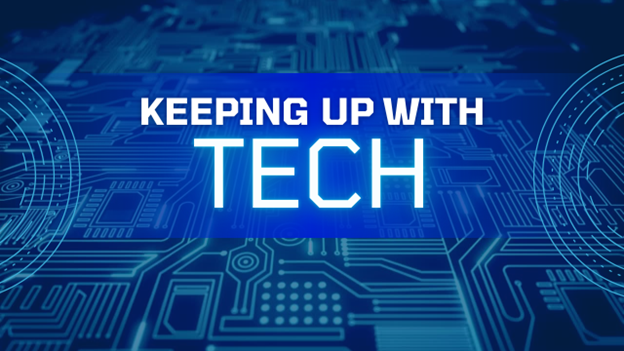
If you’re a busy professional, “keeping up with tech” can feel like a second full-time job you did not apply for. New tools launch daily. Your inbox is full of “game-changing” software. Meanwhile, you still have customers to serve, a team to lead, and probably at least 47 open browser tabs. Right? While there’s enormous pressure to keep up with innovation these days (it’ll make you more efficient), you can’t be on top of everything. And you don’t need to be. You just need a simple system that keeps you informed about the right things, so you can make smart, confident decisions to reach maximum efficiency without losing your mind (or your evenings). Start by Shrinking What “Tech” Means “Tech” is a massive category. If you treat all of it as equally important, you will burn out and do nothing. Instead, filter what you pay attention to through three questions: Will this help me grow revenue? Things that fall into this category include: better customer relationship tools, email marketing, online booking, e-commerce, paid ads, social scheduling. Will this save time or reduce friction? Things that fall into this category include: automation, project management, AI assistants, e-signatures, online forms, scheduling apps. Will this reduce risk? Things that fall into this category include: cybersecurity basics, password managers, backup systems, compliance tools. If a new technology does not hit at least one of those, it goes into the “interesting, but not for me right now” pile. You acknowledge it, you do not adopt it. Build a Tiny “Tech Intel” Ritual Keeping up with tech should not be an endless scroll. Otherwise, it becomes much like the empty promises you make to yourself of “one more reel, then back to work.” Treat it like you would your financials or strategy. Give it a container. Once a week, block out fifteen minutes on your calendar and label it “Tech Check In.” That becomes your standing appointment to look up, not just grind through. During that time, you are not randomly Googling. You are returning to a small set of trusted sources you have already chosen. Which brings us to your next move. Making the most of your time means having the learning materials at your disposal when you’re ready to review them. But ensure you keep this appointment with yourself. Otherwise, things stack up and you end up deleting them and not learning anything. Let a Few Smart People Review Things for You You do not need to read everything. You need to follow a few people who already do. Pick two or three “filters” you like, such as a newsletter that reviews tools for small businesses or your specific industry, a YouTube channel that breaks down tools and trends in simple language, or a podcast that recaps what actually matters each week. The humans behind these channels are doing the heavy lifting so you don’t have to. Your job is not to chase every link they share. Your job is to skim their summaries and ask a simple question: Could this help our revenue, our time, or our risk in the next 6 to 12 months? Again, schedule the time to actually read or listen. Subscribing is not the same as using it. During your Tech Check In, spend those fifteen minutes with their recap instead of random scrolling. Find a “Guru” Who Speaks Your Language It also helps to have one or two “gurus” you follow consistently. Not the loudest tech celebrity shouting about the future, but someone who translates tools for real-world businesses. Look for people who work with companies roughly your size, explain things in plain language, focus on outcomes and use cases (not just features), and share honest pros and cons instead of hype. You can find them by asking peers who they follow, noticing which experts show up again and again on business podcasts you like, or searching phrases like “small business tech review,” “tools for [your industry],” or “non techie tech tips.” When you find a voice that feels grounded and practical, stick with them. Consistency beats chasing a new expert every month. Let AI Be Your Research Assistant You do not have to read every two-thousand-word review to get the point. This is where AI can quietly make your life easier. You can copy an article into an AI tool and ask it to summarize the key takeaways for a small business owner and flag any obvious risks. You can paste a software homepage and ask what the product actually does, who it is best for, and whether it is overkill for a business with fewer than twenty employees. You can ask for a simple comparison between two tools you are considering. You can even create your own GPT that you train on your business and talk to it about how those products may or may not be a good fit for you. The goal is not to become a technician or a tech consultant. Instead, you want to quickly understand whether something is worth a deeper look. Use Your Network as a Shortcut You are not the only one trying to sort this out. Other people are already testing things. Borrow that. At your next networking event, ask one question that cuts to the chase: “Is there any app or software you started using this year that you now swear by?” Inside your own organization, invite more tech-comfortable team members to do short “show and tell” sessions. Ten minutes, one tool, one way it saves them time. And do not forget your chamber. Many already host tech focused webinars, workshops, or lunch-and-learns that are curated for small businesses. That curation is half the value. Experiment. Do Not Overhaul Everything. The fastest way to stall on technology is to decide you need a giant digital transformation before you do anything. You do not. You need small, low-risk experiments. Start with a single problem: missed appointments, slow invoicing, messy lead follow up, repetitive manual tasks. Choose one tool that might help, ideally with a free trial or month-to-month plan. Decide what success would look like. Fewer no-shows. Faster payment. Less time spent on a tedious process. Run a 30-to-90-day test with one team or one process, then choose to keep it, switch it, or drop it. That is it. No epic overhaul. Just repeated, thoughtful experiments. Park the Shiny Objects on a “Not Now” List You will see plenty of tools that look cool but are not right for this season in your business. Instead of feeling guilty for not jumping in, create a simple “Not Now” list. It can be a note in your phone or on Notion (it’s a cool app), a page in your planner, or a shared document. Any time you hear about something promising that is not urgent, park it there with a short note like “future CRM upgrade” or “AI chatbot to explore next year.” When you plan your quarterly or annual priorities, you can revisit that list and choose one or two to evaluate. You are not saying “never.” You are saying “not right this minute.” You Are Aiming for Literacy, Not Perfection You are not trying to become a tech expert. You are becoming a tech-literate decision maker . That looks like this: You understand, at a high level, what matters and what does not. You stay curious in small, consistent doses. You test tools in bite-sized ways. You keep the focus on how technology supports people, not the other way around. If you put even a light system around how you track and test new tools, you will be far ahead of businesses that only react when a trend goes viral. You do not need every new app. You need the right few that make your work smoother, your customers happier, and your business more resilient. That is what “keeping up with tech” looks like when you have an actual life. Read More: 15 Tech Tools to Elevate Your Work-Life Balance How to Make Time for Innovation Maximizing Efficiency: Tools and Techniques to Boost Team Productivity ----------------- Christina Metcalf is a writer and women’s speaker who believes in the power of story. She works with small businesses, chambers of commerce, and business professionals who want to make an impression and grow a loyal customer/member base. She is the author of The Glinda Principle , rediscovering the magic within. _______________________________________ Medium: @christinametcalf Facebook: @tellyourstorygetemtalking Instagram: @christinametcalfauthor LinkedIn: @christinagsmith

You already know this but you will never out-doorbuster the big box stores. You are not supposed to. Your power is not in pallets of TVs sold near cost to get people in the door. It is in how people feel when they walk through your door. If you lean into experience, Black Friday can shift from “we cannot compete” to “we own this lane.” Here’s how: 6 Ways to Win at Black Friday 1. Position Your Business as the Calm in the Chaos Black Friday is loud, crowded, and a little unhinged. Use that to your advantage by being the opposite. Think of your business as a holiday oasis. Ideas you can try: Quiet Hours Shopping. Offer “calm hours” in the early morning or later evening with softer lighting, relaxed music, and a limited number of shoppers by RSVP. This is an ideal way to stand out. Cozy Comfort Station. Set up a hydration and warmth bar. Think hot cocoa, tea, cucumber water, and maybe a simple snack. You are literally refueling tired shoppers. Phone Drop Zone. Create a “scroll break” basket where people can put their phones while they browse. Add a small sign: “You will not find peace in your notifications. Try here instead.” You become the place where shoulders drop and breathing slows. That alone is a competitive edge. 2. Make Black Friday Feel VIP, Not Bargain Bin People love to feel like insiders. Use that instinct. Ideas to elevate the day: By-Appointment Shopping. Offer 30-minute mini appointments for styling, gifting help, or product demos. Shoppers leave with decisions made and gifts checked off. First Look Access. Give your email list, top customers, or loyalty members early access to your best bundles or limited items. Frame it as a thank you, not a gimmick. “Done and Dusted” Gift Packages. Curate grab and go gift sets for specific people: “Teacher TLC,” “Hostess Hero,” “Self-Care Sunday,” “Office Secret Santa.” The value is not only in the items. It is in the decision fatigue you remove. You are not trying to be the cheapest. You are trying to be the easiest and the most thoughtful. 3. Turn Shopping into a Memory, Not a Chore If the big box experience feels like a stampede, yours can feel like a respite. Add small, memorable touches: Gratitude Wall. Invite customers to write what they are grateful for on tags or sticky notes and hang them on a wall or tree. It creates a moment of reflection and looks great on social. Photo Moments. Set up a simple photo nook. A decorated chair, a small backdrop, a “We survived Black Friday together” sign. Offer to take photos for customers on their phones. Word of Mouth Marvels. Ideally, word of mouth testimonials will come from customers in the form of reviews or social posts. But you can also use the help of your employees. Help customers feel more confident about their purchases by telling them things like, “That’s one of our biggest sellers” or “I bought that for my son’s teacher and she loved it.” These short employee-led testimonials work in-person and even as physical signs near a popular product or service. If you’re not a believer, check out how Amazon designates some of its products as “Amazon’s Choice.” 4. Create Sensory Experiences That Match Your Brand Use all five senses to stand out. Sight. Make your best bundles and gift solutions front and center. Use clear signage like “Gifts under $25” or “Perfect for the person who has everything.” Sound. Choose a playlist that fits your brand. Calm acoustic, jazzy holiday, or upbeat pop. Just be deliberate. Smell. A subtle holiday scent can make your store feel warm and inviting. Candles, diffusers, or even a simmer pot if it is safe. Taste. If allowed, offer small sips or bites. Think sample cocoa, infused water, or a local treat. Touch. Invite people to try, test, feel, and flip through. Hands-on experiences make products more real and more likely to be purchased. You want people to feel like they have stepped into a curated world, not just another errand. 5. Partner with Other Local Businesses You do not have to do Black Friday alone. Collaboration makes everything bigger without blowing your budget. Ideas: Oasis Trail. Partner with nearby businesses to create a “Holiday Sanity Route.” Each shop offers a comfort element or mini perk. Share a simple map online and in print. Shared Experiences. Host a pop-up inside your store featuring a local baker, maker, or artist. It brings their audience to you and gives your customers something extra to enjoy. This is how you turn one good experience into a whole neighborhood story. 6. Communicate Clearly and Early A great experience still needs promotion. Share your Black Friday “experience menu” on social media, your website, and via email. Focus the message on how people will feel. Less “10 percent off.” More “Skip the chaos and actually enjoy your holiday shopping.” Let your chamber know what you’re doing. They may share it in their newsletters or social feeds and send more people your way. If you can make Black Friday feel human, calm, and a little bit magical, you will not just survive it. You will stand out from all the noise and become a place people seek out year after year. They’ll feel like you understand their needs. You don’t want to compete in the race to the bottom on price. You are competing in something much more powerful: the memory of how your business made people feel in the middle of holiday madness. Read More: Last-Minute Black Friday Promo Ideas Meeting Customer Needs: Inexpensive Sensory-Friendly Ideas for the Holiday Season Tips for Reaching Holiday Shoppers This Small Business Season Unwrap the Magic: Using Nostalgia to Boost Holiday Sales ------------ Christina Metcalf is a writer and women’s speaker who believes in the power of story. She works with small businesses, chambers of commerce, and business professionals who want to make an impression and grow a loyal customer/member base. She is the author of The Glinda Principle , rediscovering the magic within. _______________________________________ Medium: @christinametcalf Facebook: @tellyourstorygetemtalking Instagram: @christinametcalfauthor LinkedIn: @christinagsmith
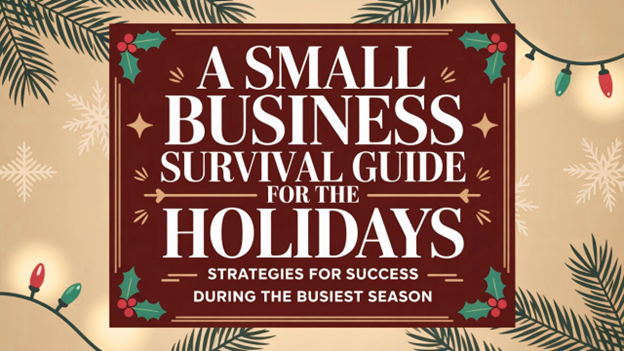
We’re fast approaching the time of year where it can like you’re running a marathon on a tightrope. Customers need attention. Promotions are queued up to be launched (or designed). Your inventory is giving you nightmares and you have huge goals for the end of the year. And you’re supposed to stay cheerful, strategic, and somehow well-rested through it all. But the problem isn’t your big aspirations for 2026, nor does the problem lie in trying to solve the things you can’t control. It’s your habits. James Clear’s Atomic Habits reminds us that meaningful results come from the small, repeatable choices we make every day. During the holidays, those tiny decisions are the difference between burnout and breakthrough. When you build systems that work even when you’re tired, distracted, or knee-deep in ribbon, the season gets lighter and your business gets stronger. Here’s how to apply some of Clear’s most practical ideas to help you not just survive the holiday season, but launch into January with invincible momentum. Start with a 1% Mindset One percent doesn’t sound like much until you stack it day after day. You don’t have to reinvent your business. You don’t need a perfect storefront, flawless offers, or an Instagram grid that looks like a lifestyle magazine. Instead, choose one area to improve just slightly. Take that one small step toward your goal. Maybe it’s tightening up your email promo schedule. Maybe it’s creating a smoother checkout flow. Maybe it’s something as simple as promising yourself (and following through on) a good night’s rest for the next month. Small refinements reduce stress and increase sales. They also remind you that progress is happening, even in chaos. Re-design Your Environment Clear says our surroundings often shape our behavior more than our motivation does. This is especially true during the holidays when the pace is high and attention is scattered. Look around your space with strategic eyes. If your workspace feels cluttered, simplify it. If your best seasonal products aren’t visible at first glance, elevate them. If your team keeps losing pens, square readers, bags, or bows, create a “holiday command center” with everything in one place. Tiny environmental shifts create smoother systems. And smoother systems prevent those frantic moments when you’re internally screaming, “Where did we put the gift bags?!” Build Habits That Support Your Busiest Days The season is unpredictable, so anchor your day with predictable habits. A few anchors to consider: • A 5-minute morning reset, before opening or seeing clients • A quick end-of-day review: what sold, what slowed down, what needs restocking, what got clicks, what impact on our customers did we see? • A customer-touch habit: one message, one email, or one thank-you note daily • A “two-minute tidy” before leaving (your future self will adore you) Consistency creates stability. When everything else feels like holiday improv, these anchors act like rhythm lines on the page. Use Systems, not Willpower If you remember nothing else from this article…pay attention… Willpower gets weaker when you get tired. Systems don’t. If you want to post consistently on social media, schedule a week’s worth of content on one calmer afternoon. If you want to upsell a holiday special, script one clear line for every team member. If you want to stay on top of inventory, set an alarm that reminds you to check key items before the weekend rush. During the holidays, systems carry you when energy can’t. Make Good Habits Easy and Bad Habits Harder Clear’s “make it obvious, make it attractive, make it easy, make it satisfying” formula is your season’s secret weapon. Want your team to use the upsell script? Keep it taped near the register or near each desk. Want customers to sign up for your loyalty program? Put the QR code where people naturally pause and that can be more than one spot. Want to stop scrolling between transactions? Keep your phone in a drawer. Design beats discipline every time. Don’t Forget Identity: Who Are You Becoming This Season? In Atomic Habits, Clear says outcomes come from identity. While you’re navigating the busiest weeks of the year, take a breath and remember who you are as a leader. · Are you the business that handles crowds with warmth? · The business that makes people feel good? · The business that takes care of its team so they can take care of customers? When you anchor yourself in identity, your choices shift. You show up differently. You communicate more intentionally. You prioritize what matters instead of chasing every glitter-coated opportunity. And your customers feel it. Give Yourself Permission to Rest This sounds counterintuitive in a season that thrives on hustle, but rest is productivity’s partner. Clear reminds us that habits compound. That includes bad ones like exhaustion, resentment, and skipping meals. Take care of yourself the way you take care of your customers. Breaks aren’t indulgent; they’re fuel. Let the Season Shape You—Without Steamrolling You You don’t need massive change. You need micro-moves that create calm, clarity, and steady revenue. If you build the right habits now, January stops being a “recovery month” and becomes a runway. Your systems will be tighter. Your team will be stronger. And you’ll have proof that even small businesses can thrive in big seasons. Read More: 16 Questions to Use to Prepare for Small Business Season Success How to Protect Your Peace During the Busiest Season in Business ------------- Christina Metcalf is a ghostwriter and speaker who believes in the power of story. She works with small businesses, chambers of commerce, and business professionals who want to make an impression and remain top of mind. She is the author of six books including her recent non-fiction book The Glinda Principle , rediscovering the magic within. _______________________________________ Facebook: @tellyourstorygetemtalking Instagram: @christinametcalfauthor LinkedIn: @christinagsmith
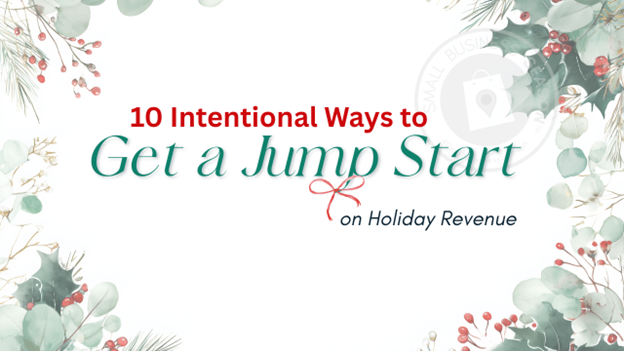
Traditionally, marketers at this time of year are busy trying to attract Black Friday and other shoppers in the days right after Thanksgiving. But thanks to the uptick in pre-Black Friday sales, today’s customers are shopping earlier than ever, spreading out their spending and looking for ways to avoid the December scramble. In fact, nearly half of U.S. shoppers now begin their holiday shopping before Black Friday. That means November isn’t just the warm-up. It’s your time to shine. With a few smart strategies, you can pull in customers before the big-box stores roll out their doorbusters and get a head start on holiday profits. Here are a few ways to catch shoppers’ attention: 1. Create a “Pre-Holiday Perk” Campaign Position early shopping as something special. Give early birds their own exclusive event—like “Thankful for You” week or a “Pre-Holiday VIP Preview.” Offer perks such as: An early access sale with limited quantities Complimentary gift wrapping for purchases before Thanksgiving Bonus loyalty points or small freebies with purchase Use phrases like “Avoid the rush—shop early and save more” or “Holiday magic starts now” to build urgency and show shoppers what’s in it for them. 2. Partner With Neighboring Businesses Join forces with nearby retailers, restaurants, and service providers to create a walkable or online “Shop Early, Shop Local” trail. Each participating business could offer something small (like a $5 coupon or treat) for visitors. when customers visit. This drives traffic as it reinforces community spirit and keeps dollars circulating locally. 3. Launch a “Grateful Giving” Promotion People love to feel generous in November. Tap into that with a cause-driven sale. Donate a percentage of early purchases to a local charity, food pantry, or school project or participate in a toy drive and give a special discount to those who donate to it. For example: A bakery could donate a loaf to a shelter or needy family for every dozen cookies sold. A restaurant could give a portion of sales on one night to a nonprofit. When shoppers know their purchase gives back, they’re more likely to buy early and buy more. 4. Bundle for the Busy Buyer Many shoppers are looking for quick, ready-to-give solutions. Create themed bundles that save them time and make you stand out. Think: “Cozy Night In” kits (candles, cocoa, and socks) “Local Taste Tour” boxes with hometown treats “Grill Master” or “Self-Care Sunday” sets Display them prominently and promote them as limited pre-holiday offers. Bonus: they make for great social media photos. 5. Host an Experience, Not Just a Sale Before the crowds hit, give people a reason to linger. Host a small in-store event, tasting, or workshop tied to the season: A “Holiday Decorating Tips” night at a home store A “Sip & Style” event at a boutique A “Pie Pairing” session at a café or winery Offer special pricing to attendees or a first look at holiday items. Events like these encourage people to shop early and to shop locally again later. 6. Reward the “Early Elves” Give a little something extra to those who shop before Thanksgiving. A small thank-you, like a coupon for their next visit in December, keeps them coming back. For instance: “Shop in November and get a $10 gift card to use in December.” It’s an easy, low-cost way to extend your holiday revenue window. 7. Promote Your November Hours and Offers Early Don’t assume customers know you’re ready for the holidays. Tell them! Use every channel you can: social media, window signs, email, and your Google Business Profile. (Don’t forget to tell us too!) Include photos of gift displays, new arrivals, or holiday décor to set the mood. And if you’ll have special hours around Thanksgiving week, post them early. One of the biggest mistakes small businesses make during this time of year is not communicating hours (or assuming because you posted once, that was enough). Many people shop online because they simply assume their favorite local store isn’t open when they want to shop. While that may be the case some of the time (no one in retail is staying open until 1:00 am just in case someone feels the need to shop), if you are extending your hours for the holiday season make sure everyone in town knows. 8. Lean Into Gratitude Messaging November is naturally about giving thanks so it’s a great marketing theme. Share posts thanking your loyal customers, featuring favorite local places or other businesses, or highlighting team members. People are more likely to support a business that feels human and heartfelt. Gratitude builds trust, and trust leads to sales. 9. Offer Early Access to Gift Cards or Experiences Gift cards are the unsung hero of early holiday marketing. Promote them as stress-free gifts before Thanksgiving with a small incentive: “Buy a $50 gift card, get $10 for yourself.” Restaurants, spas, and service businesses can pair cards with small add-ons—like a dessert, a product sample, or a digital thank-you card featuring local art. If you don’t have your own gift card program, become a participating merchant in ours. 10. Market to the “Planners and Procrastinators” Create messaging that speaks to both types of shoppers. For planners: emphasize peace of mind and avoiding the rush. For procrastinators: highlight easy solutions and limited availability. Example captions: “The best gifts don’t wait until December.” “Plan ahead, shop now, and then relax while everyone else stands in line.” November is full of potential for small businesses willing to act early. That’s why we started Small Business Season on November 1 st . Remember, we’re here to help promote your events, amplify your message, and connect you with other local businesses doing the same. Together, we can make Small Business Season the highlight of the year. Read More: Holiday Gift Card Strategies for Small Business Season Tips for Reaching Holiday Shoppers This Small Business Season
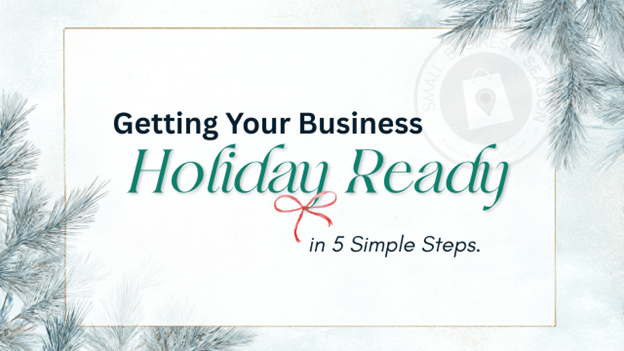
It’s officially that time of year where you have to keep looking at the calendar because it’s so hard to believe how quickly time is going or as we like to say—it’s Blurvember. The holidays have a way of sneaking up on even the most prepared businesses. One minute you’re stocking fall candles and the next you’re wondering where the extra rolls of gift wrap went. This is the moment to tighten things up so you can enjoy the revenue boost without feeling like you’re sprinting through December. Here are five simple, high-impact updates your business can make right now (some so quick you can implement them between customers) to get ahead of the holiday rush. 1. Update Your Hours and Online Info Everywhere Holiday shoppers are comparing hours, checking maps, and trying to squeeze errands between work, school pickups, and holiday events. If your hours aren’t accurate across Google, Yelp, Facebook, your website, and your chamber listing, you risk losing customers before they even leave the house. Do a quick search for your business as if you were a customer. Is your phone number right? Are your photos current? Does your holiday schedule show up clearly? Most people rely on Google’s first page, so correcting those listings now is one of the easiest wins you can score. 2. Refresh Your Signage and Displays Your storefront or lobby is a strong salesperson this time of year. When signage feels fresh and intentional, customers are more likely to stop, browse, and buy. That’s why so many storefront businesses go straight from Halloween to Christmas. Both holidays are visually appealing. In fact, people will enter your business just because you have a cool window. (Poor Thanksgiving, the middle child of holidays.) You don’t have to overhaul your entire look. A few simple updates can make a strong impression: Swap weathered signs for clean, readable replacements (unless antique is your vibe) Add one seasonal visual element that feels inviting rather than overwhelming Use clear markers for gift ideas or bestsellers Make sure curbside or pickup instructions are posted where customers can see them Even small touches create a sense of readiness that customers appreciate during a busy season. 3. Prep Your Team for Upselling Without Feeling Salesy Your staff can be your holiday heroes. A little training now can lead to bigger revenue and happier customers later. Upselling doesn’t have to feel pushy. It’s simply offering helpful suggestions that customers genuinely appreciate. Consider coaching your team on moments where a gentle recommendation is natural. Think gift wrap, add-on accessories, seasonal specials, or limited-time treats. When employees feel confident, customers feel guided. And both walk away happy. 4. Offer Gift Cards, Gift Bundles, or Quick-Grab Options The closer we get to December, the more people search for simple solutions. They’re panicked. They’re behind the eight ball (or snowball, in this case), and they just want the perfect gift that doesn’t look rushed. Gift cards are a lifesaver for anyone in a time crunch, and they’re one of the highest ROI products you can offer. If you don’t have them, this is the year to add them. Be sure to check out our online egiftcard program! You can also create: Small themed gift bundles Stocking stuffer displays Grab-and-go treats or purchase add-ons Digital gift cards for last-minute shoppers Anything that shortens decision-making for your customers will boost sales when traffic hits its peak. 5. Streamline Curbside or Online Ordering Before Things Get Busy Convenience is key during the holidays. If your online ordering, reservation system, or curbside pickup process feels a little clunky today, it will feel downright stressful on December 15. Now is the perfect time to: Run a test order Check that links work Update product descriptions Confirm your inventory tracking is accurate Make pickup instructions extremely clear Even a small digital tune-up can make the difference between a smooth holiday season and a frantic one. Bonus: Create One Holiday Highlight That Sets You Apart A lot of businesses do holiday promotions. Far fewer do something memorable. Consider spotlighting one special element this season to help you stand out. It could be a signature drink, a limited-time dish, a themed shopping night, a charity tie-in, or a mini experience customers can’t get anywhere else. Small moments of delight build loyalty. And the holidays are the perfect time to create them. Your Chamber is Here to Help You don’t have to tackle holiday readiness on your own. We’re participating in Small Business Season this year. We have a number of ways we’re supporting businesses across the community, and we want to help shine a spotlight on what you’re planning. Tell us what you’re working on, and we’ll help get the word out. Share your holiday hours, promotions, themed events, or special offerings and we’ll amplify them through our channels so more customers know exactly where to shop, dine, and celebrate. Let’s make this your smoothest and strongest holiday season yet. Read More: Holiday Gift Card Strategies for Small Businesses Simplify Seasonal Staffing for Small Business Season
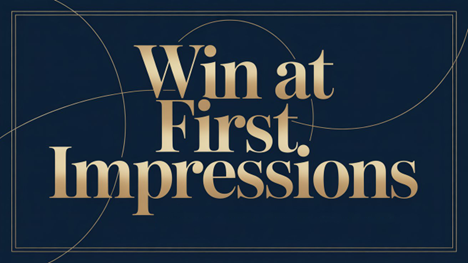
You’ve heard the old saying “You never get a second chance at a first impression.” For businesses, that isn’t just a cliché, it’s reality. Customers size up a business long before they make a purchase and often before anyone on your team even says hello. Those first 10 seconds set expectations, shape decisions, and influence how people feel about doing business with you. No matter what industry you’re in, your business is constantly sending signals about what customers can expect. The good news is that with a few intentional tweaks, you can make those signals work in your favor. Your Curb Appeal No matter what your product or service is, customers start forming an opinion the moment they approach your building. They’re asking themselves an unspoken question: Does this place look like it knows what it’s doing? Curb appeal can also speak to how professional your business comes across and how successful. People will decide whether your business is for them or not by looks alone (that goes for your website too). A few simple checks go a long way: Are your signs clean and readable from the street? Is your entry area clutter-free and welcoming? Do your posted hours match your online hours? Can customers tell which door to use or where to park? If someone has to guess how to enter or what to expect, tension rises before they step inside. A polished exterior tells customers they’re in good hands. The Digital First Impression Long before customers show up in person, many have already “visited” you online. Your website, Google Business profile, and social media pages create the first impression for a large portion of your audience. They’re looking for clarity, accuracy, and ease (even if they’re not conscious of it). A strong digital first impression includes: Updated hours and services Clear photos that reflect what customers will see in person A short, friendly description of what you do in real language that your audience uses Quick access to booking, ordering, or calling The kind of design that resonates with who your audience is (or wants to be) When your online footprint is clean, current, and helpful, customers show up confident rather than confused. The Welcome This one seems painfully obvious, but we’ve all walked into a business where the employee is on an obviously personal call or simply doesn’t recognize our existence. How did that feel? Doesn’t make you interested in buying, that’s for sure. Once a customer walks through the door, the clock starts again. Those opening seconds inside your space shape how long they’ll stay and how much they’ll trust you. No matter your industry, these moments matter. One of the fastest ways to earn trust is through a genuine welcome. A simple smile or greeting sets the tone for the visit. Customers want to feel seen and valued, not like an interruption or inconvenience. Encourage your team to greet customers in whatever way feels natural to your brand. It doesn’t need to be formal or robotic. Even a quick “Hi there, we’ll be right with you” works wonders. When customers feel acknowledged early, they’re more patient, more open to suggestions, and more comfortable asking questions. Consider: Are customers greeted promptly or at least acknowledged with eye contact (and an “I’ll be right with you,” if you’re in the middle of something)? Does the space feel organized and intentional? Can customers easily understand where to go or what to do next? Are staff members engaged or absorbed in side conversations? You don’t need to rush over and follow them around your business. You simply need to make people feel acknowledged and appreciated when they come in. The Sensory Experience First impressions aren’t just visual. Customers respond to the full environment, even when they can’t articulate why something feels “off.” Pay attention to: Lighting that feels warm rather than dim or harsh. Music that fits your brand and isn’t too loud. Temperature that’s comfortable for customers, not just employees. Clean, pleasant scents or, more importantly, no unpleasant ones but keep them subtle, too much may drive people away. Small adjustments make customers feel at ease, which makes them more likely to stay longer and return more often. Why First Impressions Shape Customer Loyalty First impressions influence today’s visit AND shape whether customers will come back, how likely they are to recommend you, and how much they trust your business. A positive experience in the first ten seconds: Lowers customer stress Builds confidence Increases perceived value Reduces complaints Boosts loyalty and spending And the best part is that improving first impressions doesn’t usually require a big budget. It requires awareness and consistency. A Simple First Impression Checklist Here’s an easy way to evaluate your business: Walk up to your location from the customer’s point of view Step inside and pause for five seconds Look around with fresh eyes Note anything that feels confusing, cluttered, or outdated Ask a friend or fellow business owner to do the same Make quick fixes where possible and plan larger improvements over time These small shifts add up quickly to create a strong competitive advantage. Read More: Are You Accidentally Repelling Perfect Clients? (Here's How to Fix It) Hospitality is the Hidden Edge: Why Emotional Connection Drives Customer Loyalty The Referral Engine: How to get People Talking About Your Business --------------------- Christina Metcalf is a ghostwriter and women’s speaker who believes in the power of story. She works with small businesses, chambers of commerce, and business professionals who want to make an impression and grow a loyal customer/member base. She is the author of The Glinda Principle , rediscovering the magic within. _______________________________________ Facebook: @tellyourstorygetemtalking Instagram: @christinametcalfauthor LinkedIn: @christinagsmith

With the holiday season approaching with the speed of a bullet train (holiday prep, year-end sales pushes, family gatherings, budget reviews, etc.), it’s no surprise many of us feel our blood pressure and tension rise, while our patience comes crashing down. While this season is one of the most exciting of the year, it brings lots of extra stress. But what if some of that stress was unavoidable? Maybe we can’t keep that troublesome relative away but we can borrow wisdom from the minimalist movement and writer Joshua Becker’s article, “The Stress We Needlessly Bring into Our Lives.” Here are four practical reframes you can share with your team and apply to your own workflow, designed specifically for business juggling multiple moving parts in busy months ahead. 1. Stop Comparing—Start Aligning It’s tempting to look at other businesses and feel like you’re falling behind. Maybe their social media looks polished, their storefront’s decorated like a movie set, or their sales numbers seem untouchable. But comparison steals focus. Your business has its own rhythm, audience, and goals. Instead of chasing what others are doing, take stock of what’s working for you. Consistency and authenticity will always outlast temporary trends. 2. Simplify Your Season Overcommitment is one of the biggest stress traps. For business owners, that often means piling on extra promotions, extending hours you can’t sustain, or saying yes to every collaboration that comes along. You might be busy and pulled in many directions but it’s unlikely you’ll feel accomplished if you overcommit yourself to trying to do it all at the same time. Imagine if you wanted to paint your entire house. If every day you woke up and painted a different area for one hour, it would be a very long time before the house would feel complete. At the end of a month, you will have put in 30 or so hours in painting but you may not even have an entire room finished. You’ll feel depleted and dissatisfied even though you spent a month working on it. This year, try doing fewer things better. Focus your efforts on what brings in customers or builds lasting relationships. Simplifying isn’t a step back; it’s a strategy for quality and control and doing more of what works, not more of a little bit of everything. 3. Build Breathing Room Into Your Calendar Every business has busy seasons, but nonstop hustle doesn’t equal progress. Schedule short breaks or “quiet hours” each week to regroup, brainstorm, or catch up. You’ll make better decisions when you’re not rushing from one task to the next. Encourage your employees to do the same. A calm, focused team provides better service and represents your business more positively, especially during the holidays, when stress levels tend to spill over. 4. Reevaluate Expectations The pressure to please customers, employees, and family can quickly become overwhelming. But not every long-standing tradition or offer is worth the toll it takes. If a particular sale or event no longer delivers value, it’s okay to let it go or reinvent it. Communicate changes early and clearly, and most customers will understand. When expectations are realistic, everyone wins. 5. Redefine Success for the Season This time of year, we tend to measure success by numbers—sales totals, event attendance, new clients. But remember, success also looks like closing the year without burnout, keeping your team motivated, or maintaining great customer experiences through the chaos. As Becker notes, “We can’t control everything. We can only control our choices.” Choose the ones that keep you steady, clear-minded, and ready for what’s next. Running a business is demanding, and the holidays only amplify that reality. As your Chamber, we encourage you to slow down where you can, focus on what truly matters, and give yourself credit for how far you’ve come. You’ve built something worth protecting—your time, your team, and your wellbeing included. As we move into the holiday season, we’re here to support your continued success, one thoughtful choice at a time. Let us know how we can help. Read More: Meeting Customer Needs: Inexpensive Sensory-Friendly Ideas for the Holiday Season Simplify Seasonal Staffing for Small Business Season Turning Gift Returns and Exchanges into Business Opportunities

As a business in our town, we want to help you this holiday season. But we also need some assistance from you. As part of Small Business Season (November 1- December 31), we’re trying to bring awareness to the importance of shopping local. Every time someone buys from a business in our town, something bigger happens than a simple transaction. Those dollars circulate through the community, supporting local jobs, funding community improvements, and creating a stronger local economy. According to studies, for every $100 spent at a locally owned business, roughly $68 stays in the community (as opposed to $43-48 when you buy online). That money helps pay employees, supports local charities and children’s programs, and keeps the lights on for other small businesses. It’s a powerful reminder that shopping local isn’t just about convenience or sentiment. It’s an investment in our shared success. As Small Business Season kicks off, it’s a great time to think about how your business fits into that story. Whether you run a retail store, a restaurant, a service company, or a home-based business, you play a part in shaping the local economy both as a provider of products and/or services and as a supporter of our community. Why It Matters to You, to Us, to Everyone It’s easy and convenient to order online but it doesn’t do as much for our community. That’s why this Small Business Season, we’re trying to educate our residents on the importance of where they spend their money. We’re asking you to help get the word out. When people understand the impact of their purchases, they’re more motivated to support local businesses. Suddenly the convenience of hitting a button doesn’t look as appealing as the appreciation they see in your eyes. How can you help? We have an easy way that you can start today. Tell Your Story You want to put a face and personality behind your business and that starts with storytelling. Share: Your personal “why.” What makes your business unique. What you love about being local. How you contribute to the community. What your family or staff loves. A picture of something in your business (or your holiday décor). Why you started your business or talk about someone who helped you along the way. What keeps you inspired. What local causes you support and why. A favorite business memory or that point you realized you were meant to do what you’re doing. These personal details are what turn shoppers into loyal supporters in the same way that getting to know someone better builds the relationship. Speaking of building relationships, here are two simple ways to start showing up in the community (and don’t be afraid to wear your branded apparel when you do): Collaborate with nearby businesses to amplify each other’s messages about buying local. We can help you with introductions, if you need them. Display a “Small Business Season” sign or “Chamber Member” sign and encourage customers to share photos when they visit. The more we work together to elevate small businesses and help our residents (and visitors) understand why every purchase here has a purpose, the stronger our community becomes. Can we count on you to be part of this message? ------------------ Looking to read more about Shop Local? - Announcement Post - 16 Questions to Use to Prepare for Small Business Season Success - Maximizing momentum From Small Business Season

If your chamber membership is gathering dust because you don't enjoy networking events, you're missing out on significant value hiding in plain sight. While mixers and ribbon cuttings get the spotlight, your membership includes strategic resources that can solve real business problems, even for those of us who hate “working a room.” Your Chamber as Problem-Solving Partner Before hiring expensive consultants or spending hours researching solutions or attending City Council meetings with time you don’t have, tap into your chamber's institutional knowledge. Most chambers field dozens of questions weekly from businesses facing similar challenges. Need a reliable commercial insurance broker? Wondering about local permit requirements? Looking for employee benefits providers? Your chamber staff has likely connected ten other businesses with exactly what you need in the past month alone. A simple phone call can save you days of research and connect you with pre-vetted resources. Leverage Collective Buying Power Your chamber membership often includes access to group rates on essential services. Health insurance, payment processing, shipping discounts, office supplies, and advertising opportunities frequently come with member pricing that can save thousands annually. Many business owners never explore these benefits because they assume switching providers is complicated. Start with one area—perhaps credit card processing fees or shipping costs—and request a comparison quote through your chamber's endorsed programs. The savings often pay for your membership several times over. - Medical Plan available to Chamber Members through Aetna Strategic Visibility Without the Small Talk Hate networking events but still need visibility? Most chambers offer alternative exposure opportunities: member spotlights in newsletters, social media features, directory listings with SEO benefits, an article in their destination guide, and quote opportunities for press releases. Volunteer for a committee that meets during business hours rather than evening mixers. You'll build deeper relationships with fewer people while contributing your expertise. Economic development, public policy, events, or education committees often need people and meet in formats more comfortable than cocktail parties. - Your membership comes with an online listing that has a customizable landing page, complete with ability to rate and review. However, if your current membership level does not include this, feel free to contact us to discuss an upgrade: Office@llchamber.com - Interested in volunteering? Let us know: Office@llchamber.com . We’re always looking for people willing to lend a hand! - We’d love to hear your praise for the Chamber—send us a short quote!. Interested? You know the email: Office@llchamber.com . - Join our 2026 Leadership class and spend time with a select group of up and coming community leaders. Currently accepting applications through December 1. Make Your Voice Count Chambers actively advocate on behalf of businesses with local and state government. Your membership gives you a direct channel to influence policies affecting your bottom line from zoning regulations to tax policies. Most chambers solicit member input on advocacy priorities but rarely hear from the majority of their membership. When your chamber sends advocacy surveys or requests feedback, take ten minutes to respond. Your specific challenges and stories give chamber leaders concrete examples when they're meeting with elected officials. -Check out our Government Affairs Committee or join them, second Thursdays monthly, 9-10AM, at the Chamber. Playlists of past events also available on YouTube ! - Check out our Military Affairs Council- they meet monthly, first Tuesdays at noon, at the conference room in Fairfield Inn & Suites. They also have quarterly MAC socials. Sign up for our December 10 th social (free!) or contact us to discuss hosting one: Office@llchamber.com. Your chamber membership is a toolkit, not a ticket to parties. Identify two or three benefits aligned with your current business needs and commit to using them this quarter. The return on investment is there. You just need to claim it. - We are also collecting survey answers to better serve our community- please let us know! It’s short (we promise!) and will enter you for a chance to win a “LeavenworthIt” Swag bag. Read More: - 10 Ways to Get the Most from your Chamber Membership - How to Build Business Connections (Even if You Hate Networking) - Local Business Partnerships Strengthen Communities and Drive Growth - Your Chamber Listing Matters More Than Ever! ----------------- Christina Metcalf is a writer/ghostwriter who believes in the power of story. She works with small businesses, chambers of commerce, and business professionals who want to make an impression and grow a loyal customer/member base. She loves road trips, hates exclamation points, and is currently reading three books at once. _______________________________________ Medium: @christinametcalf Facebook: @tellyourstorygetemtalking Instagram: @christinametcalfauthor LinkedIn: @christinagsmith

Everyone is telling you that you should be doing something with AI for your business. Every newsletter, podcast, and conference talk seems to assume you're already knee-deep in implementation. Meanwhile, you're stuck at square one (or just using it to write an email here or there), overwhelmed by options and uncertain where to begin. Welcome to AI paralysis—the small business challenge nobody's talking about. When we talk about AI paralysis, we’re not addressing the technophobe or those business owners who are resistant to change. It's understandable that they have their hesitation. But you’re different. You’re not against AI. You already use it a little but you’re not sure how to implement it in your business for maximum efficiencies. You’re just being a practical business owner and you don’t want to make an expensive mistake. But you're watching competitors post about their "AI transformation" and wondering if ChatGPT is even relevant to your industry. The fear of choosing wrong often feels worse than choosing nothing at all. Why Businesses Are Afraid of AI The paralysis typically stems from three sources. First, the options are genuinely overwhelming. Do you need a custom solution or an off-the-shelf tool? Should you be thinking about customer service bots, marketing automation, or operational efficiency? Second, the terminology is deliberately confusing. Companies slap "AI-powered" on everything, making it impossible to separate genuine innovation from rebranded software. Third, there's no clear ROI calculator for your specific situation. What works for a tech startup might be useless for a dental practice. You don't need an AI strategy with all the bells and whistles. You need to solve specific problems, and AI might be one tool in your arsenal. How to Use AI for Your Business Start by ignoring the hype entirely. Don’t just jump on the latest rollout. Instead, write down your three biggest operational headaches. Get clear on the tasks that waste time, create bottlenecks, or drive you crazy. Maybe it's answering the same customer questions repeatedly, writing product descriptions, or scheduling appointments. Don't think about AI yet. Just identify the pain. Now, for each problem, spend thirty minutes exploring if an AI tool exists that addresses it. Not researching broadly—specifically searching for solutions to that exact problem. You'll quickly discover that for many small business needs, purpose-built AI tools already exist and cost less than hiring additional help. The key is starting microscopically small. Don't implement an enterprise solution. Try one free or low-cost tool for one specific task. Use ChatGPT to draft email responses for a week. Test an AI scheduling assistant for a month. Let an AI transcription service handle your meeting notes. These tiny experiments cost almost nothing and teach you what AI can do. For most small businesses, AI's real value isn't in dramatic transformation. It's in recovering small pockets of time that accumulate into meaningful savings. Fifteen minutes saved on daily email drafts. Twenty minutes saved on social media planning. An hour saved on meeting summaries. It’s unlikely you’ll fall behind your competition because you haven’t built custom AI solutions. The businesses that will struggle in the future are those that haven’t experimented with anything at all. AI paralysis ends the moment you treat it like any other business tool: try something small, measure if it works, keep it or dump it, then move on to the next experiment. If you’re not sure where to start, check with your chamber of commerce. It’s likely they have resources, programming, or connections that can help you figure out how to use AI tools for greater efficiency. Further Reading: 5 Genius Ways AI Can Stretch Your Existing Content AI For Small Businesses: Practical Steps to Boost Efficiency and Customer Engagement AI Isn't Replacing SEO- It's Redefining It How to Win at Content With AI ----------------- Christina Metcalf is a writer and women’s speaker who believes in the power of story. She works with small businesses, chambers of commerce, and business professionals who want to make an impression and grow a loyal customer/member base. She is the author of The Glinda Principle , rediscovering the magic within. _______________________________________ Facebook: @tellyourstorygetemtalking Instagram: @christinametcalfauthor LinkedIn: @christinagsmith
